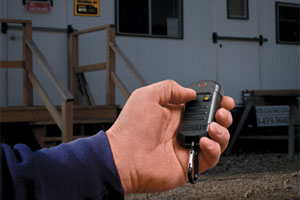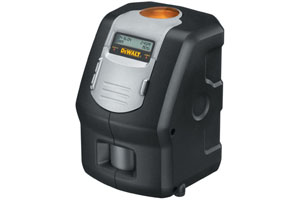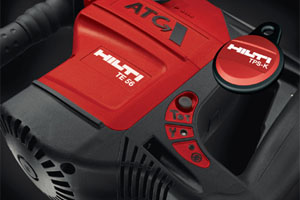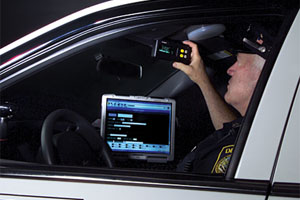Theft Costs Construction Industry More Than $1 Billion Annually
By Brett Martin

Theft of construction equipment and tools is an escalating problem across the country as employees, small-time thieves and sophisticated crime rings are ripping off contractors right on their own job sites. While hard numbers are not available, most experts agree that annual losses now exceed $1 billion.
"If you combine tools, equipment, heavy equipment and building materials, it's over $1 billion a year," said Ed DeMoss, CEO of Total Risk Management Inc. in Kansas City, Mo. "It's a problem, and it's growing."
Worse yet, stolen equipment is rarely recovered. In its "2005 Heavy Equipment Theft Report," released in January 2006, the National Equipment Register (NER) stated it had received 77,492 theft reports. According to the report, "As little as 10 percent of stolen equipment is ever recovered."
Likewise, most contractors are concerned about or have been victims of theft, according to a study by DEWALT.
"Ninety-seven percent of everyone we talked to is worried about it, and 75 percent have experienced up to five thefts each year," said Bill Pugh, the Baltimore-based company's director of marketing. "It's not just about filing insurance reports and police reports; it's fronting the cash to buy the stuff."
"We have thefts of big machinery, and it's mostly occurring on job sites. Everything is being stolen - compressors, generators, skid loaders, forklifts, heavy equipment. They're easy to heist," said Frank Scafidi, director of public affairs for the Des Plaines, Ill.-based National Insurance Crime Bureau (NICB). "If there's a market for it - and there generally is - it's just a matter of loading it up and driving it across the border."
Another problem is that one key will usually fit most construction equipment, so thieves with a master key can start and steal the machinery.
Also, when people see the equipment being loaded onto trucks, it typically doesn't raise concern. "No one thinks it's suspicious when someone loads up equipment and drives away. They think that's what's supposed to happen," said Glen Sider, operations manager for NER in New York City.
Thieves are also getting more brazen, Sider said. He cites a contractor who drove by his job site on a Sunday morning and saw a piece of heavy equipment being loaded onto a flatbed. He stopped to investigate. The men showed him paperwork from the leasing company, saying they were bringing the equipment in for servicing. Since the paperwork and explanation seemed legitimate, he let it go. The next day, when the equipment wasn't returned, he called the leasing company. He found out the equipment had been stolen right in front of his eyes.
The theft problem is further compounded by the lack of a single source for identifying and tracking equipment. Unlike vehicle identification numbers for cars and trucks, construction equipment has a variety of number and letter codes, and their placement on the machine often varies by manufacturer.
"It would be a lot easier if there were a standardized way of reporting these," Scafidi said. "What allows construction theft to be so lucrative is the ease of disguising a piece of hot equipment."
The use of incorrect equipment names when filing a theft report also adds to the confusion. The same piece of equipment may be known by a dozen different names, which can also change by region.
"We need to get some conformity so we can all talk about this and know what we're describing," Scafidi said. "Proper ID - that's the first step toward recovery."

Sider agreed. "I think most of the theft is from employees of the company who know the vulnerability of the company and want to make some extra money," he said.
Obviously, employees aren't the only ones stealing. Professional thieves are preying - and thriving - on construction equipment. In some instances, professional thieves are given a list of equipment to steal, and they do just that.
"There are two kinds of thieves. The first is impulsive; they're seeing something going by and they steal it. It's 'smash and grab.' The second is the intentional thief; they're stealing for a market," DeMoss said. "A lot of it is 'steal to order.'"
The bottom line for contractors is that the thefts are costing them big money, and in more ways than one. "If you get hit enough, you're going to have very big [insurance] deductibles," DeMoss noted.
NER's Sider said that, aside from the cost of lost equipment, contractors suffer another $300 million to $1 billion in related losses, such as down time filling out reports, lost man hours waiting for equipment replacements, scheduling conflicts, and losses or penalties for not finishing the project on time.
"Not only do you have the theft, you have the business interruption," Sider said. "I have been told that the cost of theft is factored into the cost of the job."
Indeed, contractors have had to raise their prices to recoup their theft losses.
"The real reason the home prices are rising so rapidly is not market driven. A huge portion is theft driven," Brown stated. "You have to recover what's stolen on the next job. You only get so much from the insurance company."
The problem is significant enough that it has forced contractors out of business - and not just small outfits. "I've seen one of the largest contractors go under because of theft," Brown said. "It could make or break a contractor."
Theft-related losses can be fatal for any contractor operating on a tight budget. "Some of these companies, their margins aren't that great that they can sustain this type of loss," Scafidi said. "When they go to work, they expect the equipment to be there."

Photo courtesy of Hilti
"Today, with digital cameras, it's very easy to do," he said. The NICB, which works with the police, impound lots, insurers and others to recover stolen equipment, has recovered items valued at hundreds of thousands of dollars.
Another inexpensive precaution is to make sure employees know that the boss is paying attention. Once employees realize their bosses are serious about protecting their equipment, it will reduce internal stealing, DeMoss said.
"Your employees know if you have a system in place to write down serial numbers and control numbers," he said. "If they see it, they know it's being monitored. You've got to put an internal control system in place."
NER, which has also recovered millions of dollars in equipment, has developed national databases of equipment theft and ownership records that are provided to police.
"It's a cost-effective tool," Sider said. "A thief can't take the item off the database."
An extra bonus, some insurance companies are now offering discounts for safety measures, Brown said.
He also added that contractors have a responsibility to report thefts and be diligent about pursing thieves. "Seventy-five percent of thefts that are occurring are not being reported," he said. "Contractors aren't reporting the stealing. They get all excited at the moment. After a day or two goes by, they don't pursue it."
Proactive public relations can also be an effective theft deterrent, DeMoss said. He advises contractors to inform local police about their projects, set up a 24-hour hotline for suspicious activity on the job site, and hand out company brochures to local businesses and residences when starting work in a new neighborhood.
"You've got to promote yourself," he said. "It's just good P.R."
Contractors also have to do their homework. If they know a job is located in a high crime area, they need to add security measures to the cost of the project, he said.

Photo courtesy of LoJack
The Hilti Corporation in Tulsa, Okla., sells a system that requires a key to activate a tool. Project Manager David Crawford said an employee is given a key, which is typically worn on the belt, to operate the tool. Without the key, the tool is useless, which makes it less attractive to thieves. A label identifies the tools as being protected.
"Only authorized users can use the tool. There's no way to modify the tool to make it work because it's electronically integrated," Crawford said. "You can use the tool and have the protection day and night."
It will also discourage internal stealing, he said. If an employee reports a tool missing, the contractor can then ask for the key, which the employee should always have in his or her possession.
"It transfers the ownership of the tool to the employee," Crawford said. "You can't sell the tool locked, so it makes stealing the tool useless."
In February 2005, DEWALT hit the market with SiteLock, a portable, wireless alarm system. With a base price of $1,100 and additional sensors extra, a typical system that will cover an entire job site, including trailer, costs $2,000 to $3,000, plus a $40 monthly monitoring fee, said Bill Pugh, director of DEWALT's marketing. If someone enters the secured site, the alarm activates and sends a signal to a monitoring service.
"We've got a good product that's ideal for the construction industry in helping them protect their investment," Pugh said. Also, SiteLock can be moved from one job site to the next.
With the LoJack system by the LoJack Corporation in Westwood, Mass, even if equipment is stolen, all is not lost. After achieving success with cars and trucks, LoJack introduced a version in 2001 for heavy-duty construction equipment - again meeting with success. LoJack has a 90 percent recovery rate for stolen vehicles and equipment, said Paul McMahon, director of corporate communications.
LoJack uses in-vehicle tracking equipment that emits a signal, integrated into law enforcement agencies across the country, to recover stolen equipment. It costs $795 and is good for the life of the equipment.
"We focus on one thing - that's stolen equipment recovery," McMahon said.
About the Author
Brett Martin is a freelance writer located in Shakopee, Minn. with several years of construction and writing experience.


















